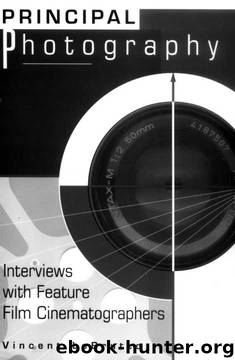Principal Photography by Vincent LoBrutto

Author:Vincent LoBrutto [LoBrutto, Vincent]
Language: eng
Format: epub
Published: 2009-05-02T09:48:00+00:00
SELECTED FILMOGRAPHY
Stroszek (codirector of photography with Thomas Mauch)
Little Wars
A Gathering of Old Men
Less Than Zero
Light Sleeper
London Kills Me
Selena
Q: Throughout the development of your career, paintings, still photographs, and movies have influenced your visual sensibilities. What images influenced you to become a cinematographer?
A: I studied painting before photography. I was interested in German expressionism because there was a visceral need to get an emotional quality and feelings towards the subject matter on the canvas. German expressionism was an outgrowth of impending doom between the wars. It was a very emotional approach to painting, abandoning academic conventions to create an expressionistic realism. Then I got interested in photography and had taken a film appreciation course at Harvard. I became cognizant that images didn't just appear on the screen. Italian director Vittorio De Sica's Umberto D greatly influenced me, as it relied heavily on images to create the story of a lonely pensioner. How De Sica told a story in just image and mood was a revelation. In the Dadaist period, Duchamp and Man Ray took commonplace objects from the real world and made a statement that this could be art too. Our perception of what we see creates it as a form of art. I've always liked what the found image could represent. So all of this attributed to the idea I could take a camera and create stories. Being frustrated learning the technique as a painter, film was a more immediate way for me to respond to images. I made my own films, and people always seemed to connect to the imagery. I approached a story by drawing back to painters and other visual references in photography as ideas to a story line. People then asked me if I would be interested in shooting their films. I thought this would be an inexpensive way to learn how to make films for myself, and I ended up becoming a cameraman.
Q: Is it the cinematographer's role to capture the director's vision or to express their own visual ideas?
A: Some directors are more visual than others. So I've always felt my job was to read the script and then bring forth visual ideas to contribute to whatever ideas the director has. Some directors formulate an idea and others don't. It is always that marriage between the director, production designer, and the cinematographer to create a visual world, but it has to emanate from the story. Every script should find its own filmic language, its own visual grammar, and the discovery of that grammar has always been an important aspect for me. It's something that evolves. You bring in a lot of visual ideas and references. They could come from books, films, or paintings. Whatever the visual references are, it's important to play that game with each other to then find what's unique about that script, that story.
Q: Is there a protocol for how that process unfolds? When you read a script, do you share your visual ideas with the director right away or do
Download
This site does not store any files on its server. We only index and link to content provided by other sites. Please contact the content providers to delete copyright contents if any and email us, we'll remove relevant links or contents immediately.
Aircraft Design of WWII: A Sketchbook by Lockheed Aircraft Corporation(32188)
The Great Music City by Andrea Baker(31248)
Call Me by Your Name by André Aciman(20347)
The Secret History by Donna Tartt(18803)
The Art of Boudoir Photography: How to Create Stunning Photographs of Women by Christa Meola(18503)
Shoot Sexy by Ryan Armbrust(17637)
Plagued by Fire by Paul Hendrickson(17313)
Portrait Mastery in Black & White: Learn the Signature Style of a Legendary Photographer by Tim Kelly(16932)
Adobe Camera Raw For Digital Photographers Only by Rob Sheppard(16880)
Photographically Speaking: A Deeper Look at Creating Stronger Images (Eva Spring's Library) by David duChemin(16598)
Ready Player One by Cline Ernest(14490)
Pimp by Iceberg Slim(14312)
Bombshells: Glamour Girls of a Lifetime by Sullivan Steve(13949)
The Goal (Off-Campus #4) by Elle Kennedy(13459)
Art Nude Photography Explained: How to Photograph and Understand Great Art Nude Images by Simon Walden(12951)
Kathy Andrews Collection by Kathy Andrews(11706)
The Priory of the Orange Tree by Samantha Shannon(8851)
The remains of the day by Kazuo Ishiguro(8785)
Thirteen Reasons Why by Jay Asher(8765)
